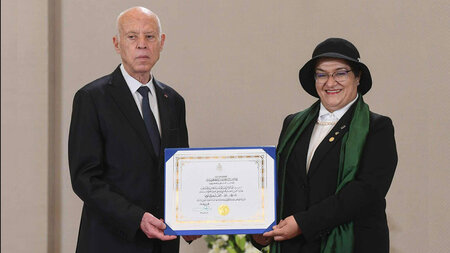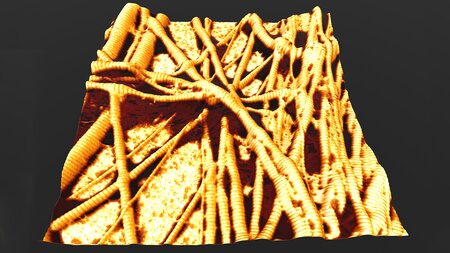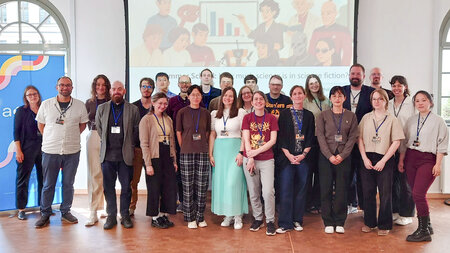Experience exhibitions together: multi-touch in the museum
TU Chemnitz and Saxon Museum of Industry want to demonstrate not only to children, how the acquired knowledge in exhibitions can be deepened playfully
-

Kalja Kanellopoulos (left), museum director Andrea Riedel and Michael Storz test a card game on an interactive multi-touch table which can be used by visitors to learn more about exhibitions playfully. Picture: Mario Steinebach
In the digital world it is not easy for museums to impart knowledge in a modern way or to create a contemporary access to exhibits that come from another time. Therefore the Saxon Museum of Industry in Chemnitz in cooperation with TU Chemnitz decided to work together in an innovative way in order to solve this problem.
In the exhibition area of the museum this is already visible - there is a colorful table with illuminated surface. At the moment four enthusiastic children are sitting around the table and using their fingers to play virtual cards. The aim of the players is to sort museum exhibits in a chronological order. The players alternately place a card in the middle. If you are wrong you get a penalty card. The winner is the player who first of all has no cards left.
This sounds simple, but it is not. The interdisciplinary graduate program `CrossWorlds´ at the TU developed in a longstanding project the interactive multi-touch table, its ingenious design and hidden inside software. The project is implemented in cooperation with the Saxon Museum of Industry. Since April 2012, the computer scientist Michael Storz and the social scientist Kalja Kanellopoulos have been working on the development of this multi-user compatible table. Countless video recordings of user situations, sketches, photos and interviews with museum visitors and staff have already been evaluated. Until 11th December 2013 also a large-scale empirical study is set up. Each intermediate result is included in the optimization and enhancement of the table. The project is funded until April 2015 by the German Research Foundation. "Finally all the equipment remains in the Saxon Museum of Industry, where visitors can use the 46-inch screen with its multi-touch surface in the future even to assemble a Trabant", says Dr. Rita Müller, Senior Research Fellow at the Saxon Museum of Industry.
Further technical refinements will be added until the end of the project. "Our aim is that the table is able to recognize its users by integrated cameras and offer appropriate interaction services automatically depending on the number of participants or estimated age", says Storz. In charge of the project at TU Chemnitz are Prof. Dr. Claudia Fraas (Professorship of Media Communication) and Prof. Dr. Maximilian Eibl (Professorship of Media Informatics). The product designer Julia Franke from Chemnitz, who developed in cooperation with researchers of TU Chemnitz for the Saxon Museum of Industry the design concept for the interactive table, is also involved. "Because of the arrangement of various free, seat, knee and foot plates the table could by used by different groups such as children, adolescents, adults, older visitors or wheelchair users", explains the designer. The development team is also supported by further students of Media Communication and Media Informatics.
In a period of four weeks as part of the empirical study the current prototype of the multi-touch table is tested in the Saxon Museum of Industry. The table has had great response so far as more than 500 people participated in the study. "Not only children are enthusiastic about the interactive table. The feedback of adults is very positive as well”, says Kanellopoulos. The recorded video and the recorded conversations will be evaluated using social scientific methods and will be analyzed afterwards. As a result, the design of the table and its applications will be developed successively and optimized by the researchers. First adaptations of the card game could already be made in the course of the study.
For more information, please contact Kalja Kanellopoulos, phone 0371 531-32493, e-mail kalja.kanellopoulos@phil.tu-chemnitz.de, http://crossworlds.info
(Author: Mario Steinebach, Translation: Jakob Landwehr)
Katharina Thehos
11.12.2013




